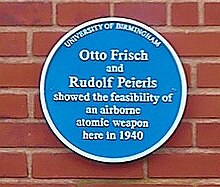Otto Robert Frisch
Otto Robert Frisch Atomic bomb | |
|---|---|
| Awards | Fellow of the Royal Society[1] |
| Scientific career | |
| Fields | Physics |
| Signature | |
 | |
Otto Robert Frisch
Early life
Frisch was born in
Nuclear physics
After some years working in relatively obscure laboratories in Germany, Frisch obtained a position in Hamburg under the Nobel Prize-winning scientist Otto Stern. Here he produced work on the diffraction of atoms (using crystal surfaces) and also proved that the magnetic moment of the proton was much larger than had been previously supposed.[4]
The accession of
Nuclear fission
During the Christmas holiday in 1938, he visited his aunt Lise Meitner in Kungälv. While there she received the news that Otto Hahn and Fritz Strassmann in Berlin had discovered that the collision of a neutron with a uranium nucleus produced the element barium as one of its byproducts. Hahn, in a letter to Meitner, called this new reaction a "bursting" of the uranium nucleus. Frisch and Meitner hypothesized that the uranium nucleus had split in two, explained the process, and estimated the energy released, and Frisch coined the term fission, adopted from a process in biology, to describe it.[6][7]
Political restraints of the Nazi era forced the teams of Hahn and Strassmann and that of Frisch and Meitner (both of whom were Jewish) to publish separately. Hahn's paper described the experiment and the finding of the barium byproduct.[8] Meitner's and Frisch's paper explained the physics behind the phenomenon.[9]
Frisch went back to Copenhagen, where he was quickly able to isolate the pieces produced by fission reactions.[10] As Frisch himself later recalled, a fundamental idea of the direct experimental proof of the nuclear fission was suggested to him by George Placzek.[11][12] Many feel that Meitner and Frisch deserved Nobel Prize recognition for their contributions to understanding fission.[13]
In mid-1939 Frisch left Denmark for what he anticipated would be a short trip to
Manhattan Project

In 1944 at
He also designed the "dragon's tail" or "guillotine" experiment in which a uranium slug was dropped through a hole in larger fixed mass of uranium, reaching just above critical mass (0.1%) for a fraction of a second.[18] At the meeting to approve the experiment, Richard Feynman, commenting on the transient danger involved, said it was "just like tickling the tail of a sleeping dragon." In the period of about 3 milliseconds, the temperature rose at a rate of 2000 °C per sec and over 1015 excess neutrons were emitted.[19]
Return to England

In 1946 he returned to England to take up the post of head of the nuclear physics division of the Atomic Energy Research Establishment at Harwell, though he also spent much of the next thirty years teaching at Cambridge where he was Jacksonian Professor of Natural Philosophy[5] and a fellow of Trinity College.
Before he retired he designed[20] a device, SWEEPNIK, that used a laser and computer to measure tracks in bubble chambers. Seeing that this had wider applications, he helped found a company, Laser-Scan Limited, now known as Laser-Scan Engineering Ltd., to exploit the idea.
Retirement

He retired from the chair in 1972 as required by University regulations.[20] He died on 22 September 1979.[5]
References
- ^ JSTOR 769874.
- doi:10.1063/1.2913924. Archived from the originalon 28 September 2013.
- ^ "Otto Robert Frisch | Biography & Facts". Encyclopedia Brittanica. Retrieved 21 December 2023.
- S2CID 120793548.
- ^ ISBN 978-0-684-86315-3. Retrieved 4 December 2021.
- ISBN 978-1-61234-890-2.
- OCLC 13793436.
- S2CID 5920336. The authors were identified as being at the Kaiser-Wilhelm-Institut für Chemie, Berlin-Dahlem. Received 22 December 1938.
- S2CID 4113262. The paper is dated 16 January 1939. Meitner is identified as being at the Physical Institute, Academy of Sciences, Stockholm. Frisch is identified as being at the Institute of Theoretical Physics, University of Copenhagen.
- S2CID 4076376. The paper is dated 17 January 1939. [The experiment for this letter to the editor was conducted on 13 January 1939; see Rhodes, Richard (1986). The Making of the Atomic Bomb. Simon and Schuster. pp. 263and 268.
- ^ Otto R. Frisch, "The Discovery of Fission – How It All Began", Physics Today, V20, N11, pp. 43-48 (1967).
- ^ J. A. Wheeler, "Mechanism of Fission", Physics Today V20, N11, pp. 49-52 (1967).
- ^ "Fame without a Nobel Prize". 5 November 2015.
- ^ "Culture trails – Blue Plaque Guide" (PDF). University of Birmingham. Retrieved 4 December 2021.
- ^ Rhodes, Richard (1986). The Making of the Atomic Bomb. Simon and Schuster. pp. 612–613.
- ^ ISBN 0-52-128010-9.
We were building an unusual assembly, with no reflecting material around it; just the reacting compound of uranium-235 ... For obvious reasons we called it the Lady Godiva assembly.
- ISBN 9780671441333.
- ^ "Here Be Dragons".
- )
- ^ ISBN 0-521-40583-1
Bibliography
- Atomic Physics Today (1961)
- Working with ATOMS (1965)
- What Little I Remember (1979)
External links
- Annotated bibliography for Otto Frisch from the Alsos Digital Library for Nuclear Issues
- Los Alamos National Laboratory on the British mission
- Oral history interview transcript with Otto Robert Frisch on 8 May 1963, American Institute of Physics, Niels Bohr Library & Archives
- Oral history interview transcript with Otto Robert Frisch on 3 May 1967, American Institute of Physics, Niels Bohr Library & Archives
- "On the Feasibility of Coal-Driven Power Stations" (Spoof essay by Frisch written in commemoration of the 70th birthday of Niels Bohr, 7 October 1955)
- Works by or about Otto Robert Frisch at Internet Archive
